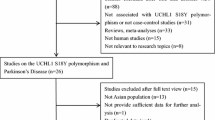Abstract
Study objectives.
To discover the associations between HMOX-1 and sporadic Parkinson’s disease (PD).
Methods
Five hundred sporadic PD patients and 500 healthy controls were recruited in this study. Polymerase chain reaction (PCR) was used.
Results
The dominant model of HMOX-1 rs2071747 was shown statistically significant between PD patients and control after adjustment of age and gender (dominant model: p value: 0.045, OR: 1.51, 95% CI: 1.01–2.27, adjusted). The associations of additive model and dominant model of rs2071747 were also found (additive model: p value: 0.047; dominant model: p value: 0.035, OR: 1.55, 95% CI: 1.03, 2.34).
Conclusions
We found the association of the dominant of HMOX1 rs2071747 with PD. We also found the associations of additive model and dominant model of HMOX1 rs2071747 with late onset PD (LOPD) patients.
Highlights
• The dominant model of HMOX1 rs2071747 was associated with PD.
• The additive model of HMOX1 rs2071747 was associated with LOPD.
• The dominant model of HMOX1 rs2071747 was associated with LOPD.
Similar content being viewed by others
Abbreviations
- CI:
-
Confidence interval
- EOPD:
-
Early onset Parkinson’s disease
- HO-1:
-
Heme oxygenase-1
- HWE:
-
Hardy-Weinberg equilibrium
- LOPD:
-
Late onset Parkinson’s disease
- MDS:
-
Movement disorders society
- NCBI:
-
National Center for Biotechnology Information
- OR:
-
Odds ratio
- PCR:
-
Polymerase chain reaction
- PD:
-
Parkinson’s disease
- SNP:
-
Single nucleotide polymorphism
References
Kalia LV, Lang AE (2015) Parkinson’s disease. Lancet 386(9996):896–912
Li G et al (2019) Parkinson’s disease in China: a forty-year growing track of bedside work. Transl Neurodegener 8:22
Ascherio A, Schwarzschild MA (2016) The epidemiology of Parkinson’s disease: risk factors and prevention. Lancet Neurol 15(12):1257–1272
Masaldan S et al (2019) Striking while the iron is hot: iron metabolism and ferroptosis in neurodegeneration. Free Radical Biol Med 133:221–233
García-Martín E et al (2015) Heme oxygenase-1 and 2 common genetic variants and risk for restless legs syndrome. Medicine 94(34):e1448–e1448
Agúndez JAG et al (2016) Heme oxygenase-1 and 2 common genetic variants and risk for multiple sclerosis. Sci Rep 6:20830–20830
Ayuso P et al (2014) An association study between heme oxygenase-1 genetic variants and Parkinson’s disease. Front Cell Neurosci 8:298
Klingelhoefer L, Bhattacharya K, Reichmann H (2016) Restless legs syndrome. Clin Med (Lond) 16(4):379–382
Postuma RB et al (2015) MDS clinical diagnostic criteria for Parkinson’s disease. Mov Disord 30(12):1591–1601
Li G et al (2018) Association of GALC, ZNF184, IL1R2 and ELOVL7 With Parkinson’s Disease in Southern Chinese. Front Aging Neurosci 10:402
Dupont WD, Plummer WD Jr (1990) Power and sample size calculations. A review and computer program. Control Clin Trials. 11(2):116–28
Dupont WD, Plummer WD Jr (1998) Power and sample size calculations for studies involving linear regression. Control Clin Trials 19(6):589–601
Schipper HM et al (2019) The sinister face of heme oxygenase-1 in brain aging and disease. Prog Neurobiol 172:40–70
Park JS et al (2019) Neuroprotective effect of β-Lapachone in MPTP-induced Parkinson’s disease mouse model: involvement of astroglial p-AMPK/Nrf2/HO-1 signaling pathways. Biomol Ther (Seoul) 27(2):178–184
Nitti M et al (2018) Heme oxygenase 1 in the nervous system: does it favor neuronal cell survival or induce neurodegeneration? Int J Mol Sci 19(8):2260
Huang B et al (2018) α-Cyperone inhibits LPS-induced inflammation in BV-2 cells through activation of Akt/Nrf2/HO-1 and suppression of the NF-κB pathway. Food Funct 9(5):2735–2743
Jeong YH et al (2019) Atractylodis Rhizoma Alba attenuates neuroinflammation in BV2 microglia upon LPS stimulation by inducing HO-1 activity and inhibiting NF-κB and MAPK. Int J Mol Sci 20(16):4015
Cui B et al (2019) Farrerol attenuates β-amyloid-induced oxidative stress and inflammation through Nrf2/Keap1 pathway in a microglia cell line. Biomed Pharmacother 109:112–119
Lane DJR, Ayton S, Bush AI (2018) Iron and Alzheimer’s disease: an update on emerging mechanisms. J Alzheimer Disease 64(s1):S379–S395
Belaidi AA, Bush AI (2016) Iron neurochemistry in Alzheimer’s disease and Parkinson’s disease: targets for therapeutics. J Neurochem 139(Suppl 1):179–197
Zucca FA et al (2017) Interactions of iron, dopamine and neuromelanin pathways in brain aging and Parkinson’s disease. Prog Neurobiol 155:96–119
Ren J et al (2019) Tricetin protects against 6-OHDA-induced neurotoxicity in Parkinson’s disease model by activating Nrf2/HO-1 signaling pathway and preventing mitochondria-dependent apoptosis pathway. Toxicol Appl Pharmacol 378:114617
Xu W et al (2017) Glaucocalyxin B alleviates lipopolysaccharide-induced Parkinson’s disease by inhibiting TLR/NF-κB and activating Nrf2/HO-1 pathway. Cell Physiol Biochem 44(6):2091–2104
Mostile G et al (2017) Iron and Parkinson’s disease: a systematic review and meta-analysis. Mol Med Rep 15(5):3383–3389
Acknowledgements
We thank all the patients who participated in this study.
Funding
This work was supported by grants from the National Natural Science Foundation of China 81601106 (to Ran Xiong).
the national natural science foundation of china,81601106,Ran Xiong
Author information
Authors and Affiliations
Contributions
Ran Xiong collected the PD and control data, performed the statistical analysis, and drafted the manuscript. Bei Zhang collected the PD data. Ran Xiong designed the study, supervised the study, double-checked the statistical analysis, and revised the manuscript.
Corresponding author
Ethics declarations
Conflict of interest
The authors declare no competing interests.
Ethical approval
This study was approved by the ethic committee of East Hospital, Tongji University School of Medicine. There were no participants whose age was under 18 years old when we assess
Informed consent statement
All participants and their caregivers were fully informed. They signed written consent forms after informed.
Additional information
Publisher's Note
Springer Nature remains neutral with regard to jurisdictional claims in published maps and institutional affiliations.
Rights and permissions
About this article
Cite this article
Xiong, R., Zhang, B. Association of HMOX-1 rs2071747 with sporadic Parkinson’s disease in southern Han Chinese. Neurol Sci 43, 3671–3675 (2022). https://doi.org/10.1007/s10072-021-05830-x
Received:
Accepted:
Published:
Issue Date:
DOI: https://doi.org/10.1007/s10072-021-05830-x




